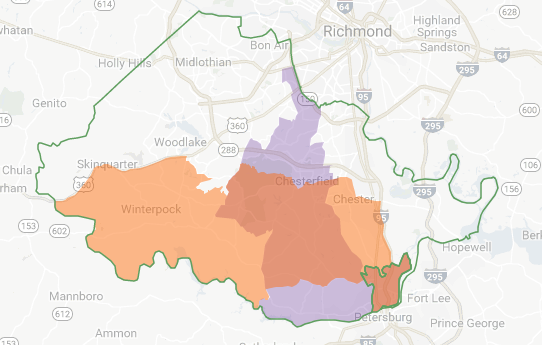The Court’s New Lines Will Elect More Democrats. Will It Increase Black Representation?
Earlier this week, I wrote about the process by which the District Court ruled illegal the partisan Republican gerrymander in the House of Delegates, while keeping in place the partisan Democratic gerrymander in the State Senate. The ruling was based off of racial considerations, but Democrats are celebrating it as a partisan victory.
As a reminder, the ruling was that by using a 55 percent standard to create districts that would be likely to elect minority representatives, this was illegally using race as a predominant factor in drawing lines. The implication was that Republicans “packed” districts in order to diminish the electoral impact of black voters. Thus, by unpacking, then more black Delegates will get elected.
So, it’s only fair to look to see how the Court’s meddling is playing out.
For this analysis, I relied on the 2017 Governor’s vote share. Due to the presence of a Libertarian, this may slightly underestimate GOP chances in these districts. For the old districts, I used VPAP’s numbers. For the newly drawn districts, I relied on Daily Kos Election’s numbers. BVAP percent numbers came directly from the Report of the Special Master.
Overall, there are 25 House Districts that changed. From there, we can break them into five categories:
1) Uncompetitive Districts With Minimal Changes
HD-62 (Ingram – R)
HD-64 (Brewer – R)
HD-78 (Leftwich – R)
HD-93 (Mullin – D)
These four districts saw less than a 5 percent change in either the percentage of black voters or their % of Gillespie vote. Three of these are Republican districts: Ingram’s 62nd (which is open in 2019) actually got slightly more Republican, and is not being seriously challenged; Brewer’s 64th district, where she is heavily favored to win re-election; and Leftwich’s 78th district, which is now a 58 percent Gillespie district and not competitive in the fall.
The last is Mark Mullin’s 93rd District, which was one of the bigger swings due to redistricting (towards Republicans) and could theoretically be competitive. It gave Gillespie 43 percent of the vote, more than districts like the 31st and 50th in Prince William County which are expected to be competitive. Sadly, the Republican challenger has raised a scant 100 bucks so far.
2) 12 Districts that were found to have an unconstitutional 55%+ minority vote.
HD 63, 69, 70, 71, 74, 75, 77, 80, 89, 90, 92, 95
Technically, there were only 11 districts found unconstitutional, as the court determined that HD-75 had a justification beyond race for its shape. However, it was still marked by its 55 percent BVAP level, and the Special Master adjusted that downwards just like the other 11, so I’m including it on this list.
Obviously, none of these races are competitive in 2019 (you could perhaps make a case for HD-63, but there’s no Republican challenger there regardless).
Below is a chart of these twelve districts and their % of black vote from before redistricting and after:
What’s most notable is how small these changes are. Eight of the 12 see a BVAP shift of 6 points or less. Almost half of them are 3 points or less.
This is actually quite interesting and important, because it undermines the entire narrative that left-wing partisan hacks are promoting. A 3-point shift is simply not substantial enough to constitute the difference between a “packed” and an “unpacked” district. Yet the court-decided remedy requires such little change to correct for most of the districts.
In effect, in the opinion of the court, district lines that have HD-70 as a 56 percent black district and HD-71 as a 55 percent black district is horrendous racial oppression, a clear effort to disenfranchise black voters and carry the legacy of Jim Crow.
By stark contrast, making these 54 percent BVAP districts (instead of 55 percent or 56 percent) perfect arbiter of fairness, equality, and justice. That one percent and two percent difference, according to the Courts, all the difference.
Here’s how the other 8 districts play out:
3) GOP Pickup Opportunities
HD-72 (VanValkenburg)
HD-85 (OPEN)
These two districts hardly changed at all due to the redistricting. Because the changes are so minor, any outcome in these races cannot be said to be a “fix” engineered by the court.
In HD-85, the Democratic candidate, Alex Askew, happens to be black (and an elementary school classmate of mine — College Park Cougar til I die!); but in a district that is only 21 percent black, this is not an “expected” outcome in the eyes of the court. That is, their judicial remedy didn’t include any changes in HD-85 in order to make it easier (or more difficult) for a black candidate to get elected.
4) Highly Funded, Highly Competitive Democratic Pickup Opportunities
HD-83 (Stolle – R)
HD-91 (OPEN)
HD-94 (Yancey – R)
These districts each shifted a bit; as a result, the most Republican of the three is a district where Gillespie got only 45 percent of the vote. Thus, all three of these districts are Democratic targets. As evidence of that, each Democratic challenger has raised $80K or more so far (one has raised almost $200K).
All three Democrats are white.
Two of the nominations were uncontested; in the Hampton-based HD-91, there was a competitive Democratic primary. Both candidates were white.
I don’t care about the race of a candidate, but the court does. This new map isn’t supposed to correct partisan gerrymandering. The entire rationale behind this case was to increase minority representation, something the court argued was harmed by the original lines drawn at a 55 percent standard.
So the court ordered these lines redrawn, and as a result, each of these three districts have a strong chance to flip from Republican to Democrat. However, black representation will increase here by 0.00 percent.
5) Potentially Competitive Seats with Black Challengers
HD-66 (Cox – R)
HD-76 (Jones – R)
HD-81 (Knight – R)
The new HD-81 was made into only a 25 percent black district, so it was not designed by the court to ensure a minority representative. Either way, Knight is heavily favored to win; Jenkins has only raised $24K so far, with $3,600 of that coming from himself.
That leaves HD-66 and HD-76 — Kirk Cox, the Speaker of the House, and Chris Jones, the principal architect of the GOP House lines.
First, let’s take a second and appreciate the sheer “coincidence” that a court-ordered redistricting, which has already shown to produce overly partisan outcomes, ended up impacting most two prominent Republican leaders including the Speaker of the House.
It would be poetic injustice if both seats were to flip in November. But how likely, actually, is that?
On paper, HD-66 is the less competitive of the two. With Gillespie earning 47 percent of the vote here, it is on par with Barry Knight’s district. Plus, as House Speaker, Cox is sitting on a massive war chest. His opponent, Sheila Bynum-Coleman, has done an alright job of fundraising, with $61K so far, but $16K of that has come from her or her husband, leaving just $48K raised total.
What makes HD-66 so dangerous for Republicans is the fact that the court took away over half of Kirk Cox’s old district. Take a look at the new lines below. Adding up the votes in the shifted precincts, Cox is retaining just 48 percent of his old district, and introducing himself to over half of his new district (with just months before the election and after session is finished).

Finally, there’s HD-76, whose district dropped from Gillespie 49 percent to 39 percent. That puts Jones on the same level as David Yancey’s HD-94 in terms of competitiveness. If Jones loses, it will be solely because of this court-ordered shift.
Jones’ district also jumped from 25 percent to 43 percent black, putting it at the same level as some of the newly unpacked districts with black representatives. And Chris Jones’ opponent, Clint Jenkins, is black.
Thus, HD-76 represents the single, sole district that might accomplish the court’s goal of increasing black representation by “fixing” “packed” districts (assuming Kirk Cox’s lean-GOP district and large warchest prevails). The court shuffled the lines in 25 districts across the state, and they might get one additional district designed to elect a black delegate out of all that work.
Except, in order to win elections, you need to raise money. Fundraising is also a show of how competitive each party feels the race is. So far, Democrats and donors aren’t treating this as a competitive race. Chris Jones has raised almost a half-million dollars so far. The Democrat, only $12,500 in not in-kind donations, from just 14 donors.
Here is the fundraising disparity between the two:
As I said in my post earlier this week, the court’s remedy for an alleged racial gerrymander is a partisan gerrymander in favor of Democrats. This isn’t spin; this is literally what the lawyer for Democrats is claiming credit for:
No tears. In fact I won the racially gerrymandering case I argued — Justices Gorsuch and Thomas joined in the opinion. The result will be fair maps and a Democratic majority in the Virginia Legislature after this Fall’s elections. Thanks for asking. https://t.co/HcaPFDH11q
— Marc E. Elias (@marceelias) June 30, 2019
Notice what he touts and what he excludes. There’s no mention at all of increasing minority representation — the entire reason behind the Voting Rights Act and the fig leaf rationale for his lawsuit in the first place. Perhaps because Elias knows, as well as anybody who has studied these races, that these maps will only be marginally effective, if effective at all, in accomplishing that goal.
This is further testament to the notion that the 55 percent standard Republicans used in 2011 was not trying to pack voters to decrease minority representation. Even with free rein to redraw the lines, including taking over half of a district away from incumbents, most districts they “unpacked” only shifted by a few percentage points.
No, what Elias (and most Democrats in the few moments they’re honest) is celebrating is using the courts, behind a questionable racial gerrymandering lawsuit, to help Democrats achieve a partisan gerrymander that they couldn’t accomplish with a legislature. It’s a shame that the Supreme Court didn’t hear the case on its merits rather than dismissing it on standing issues. I’d be curious how they would react to the interpretation that in the event of perceived violations of the Voting Rights Act, the proper judicial recourse is, “Help Democrats Win.”




